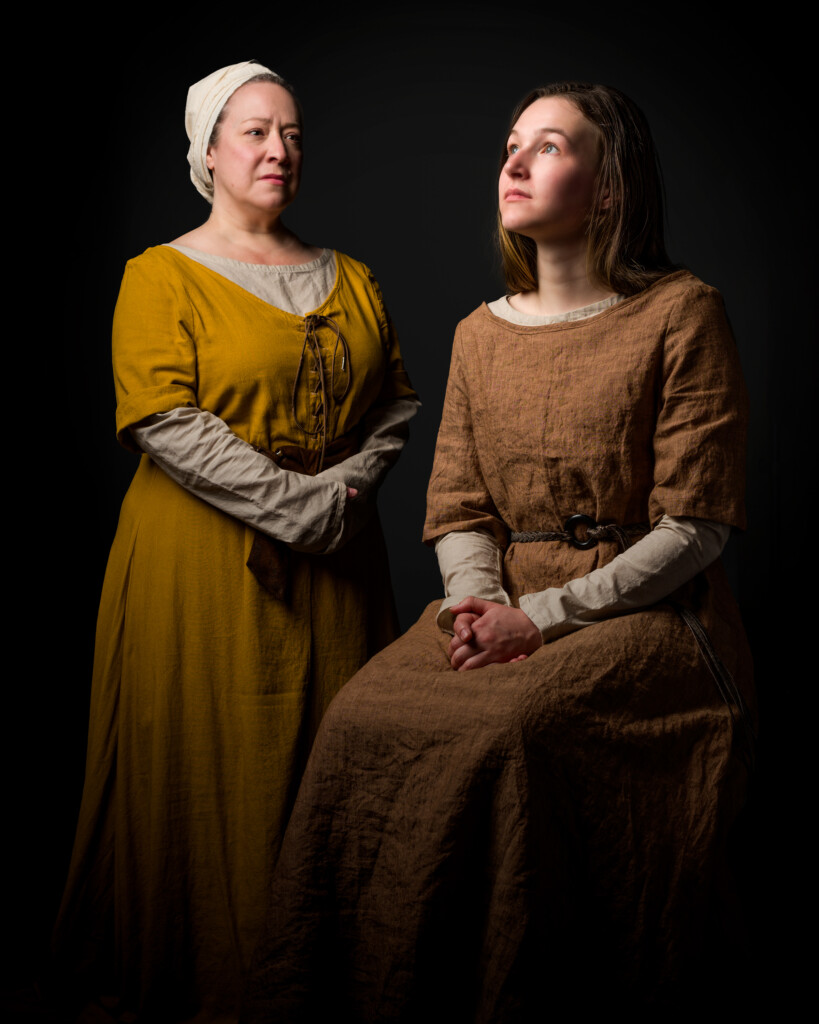In the introduction to her superlative biography Joan of Arc: A History (2014), Helen Castor wrote about her subject’s unique position as historical figure and as an epitome of Medieval Age culture, military history, politics and religious faith: “Unsurprisingly, the effect of Joan’s gravitational field – the self-defining narrative pull of her mission – is equally apparent in historical accounts of her life. Most begin not with the story of the long and bitter war that had ravaged France since before she was born, but with Joan herself hearing voices in her village of Domrémy in the far east of the kingdom. That means that we come to the dauphin’s court at Chinon with Joan, rather than experiencing the shock of her arrival, and as a result it’s not easy to understand the full complexity of the political context into which she walked, or the nature of the responses she received.”
At the end of her 300-page book, Castor illuminates the context of comprehending Joan’s life, by going beyond the fact that she was canonized as a saint. “If we immerse ourselves in her cultured, brutal and terrifying uncertain world, assured of nothing but the supreme force of God’s will, then perhaps we can begin to understand Joan herself: what she thought she was doing; why those around her responded as they did; how she took her chance, to miraculous effect; and what happened, in the end, when the miracles stopped.”

Photo Credit: Robert Holman.
In her 2018 play Mother of the Maid, Jane Anderson ingeniously reimagined that “cultured, brutal and terrifying uncertain world” of Joan’s time, by situating the narrative, as told from the lens of Joan’s mother. In a superbly acted production, PYGmalion Theatre Company makes this Utah premiere a fascinating, absorbing piece of chamber theater that whets one’s appetite to revisit the history of one of the most well documented historical figures of the early 15th century. Directed by Teresa Sanderson, the production puts the final flourishes on a supremely successful season for PYGmalion Theatre Company.
In her trademark performing style, April Fossen commands the stage as Isabelle Arc, Joan’s mother. Fossen’s signature acting skills have been visible in various characters she has portrayed throughout the years, which are shaped by the complexities of faith and when they are tested and confounded by extraordinary events involving the narrative’s principal figures. Indeed, Joan of Arc was simultaneously revered and feared, subsequently executed in her teens as a heretic but who also would eventually be exculpated in the middle of the 15th century and canonized in the early 20th century.

Photo Credit: Robert Holman.
Fossen’s emotional displays are natural and wholly credible, especially when she tries to grasp her daughter’s earnest claims that she has had prophetic visions. They are equally strong when she stands up for Joan against Jacques, her husband who is not only skeptical but also alarmed at Joan’s violations of divine law by dressing in men’s clothing. Matthew Ivan Bennett, one of Utah’s best known playwrights who periodically takes his place as an actor in local productions, proves to be the perfect match, as the husband. The performing chemistry is incontrovertible in its believability, reinforced just as compellingly by Addie Bowler, who plays Joan, with an evident appreciation of the unique gravity of the historical figure’s legacy.
Likewise, the other three actors in the production enrich the emotional palette with control and nuance: Alvaro Cortez as Pierre, the brother; Jesse Nepivoda as the priest and Jensie Anderson, who plays the Lady of the Court.
In a 2018 Forbes interview, Anderson explained why she was inspired to write a theatrical treatment of one of history’s greatest proto-feminists, from the main perspective of Joan’s mother. “When I became a mother myself I finally understood how hard it was for my own mother to raise a daughter like me,” she said. “I felt compelled to find Isabelle Arc’s voice, this simple-seeming peasant woman who turns out to be so incredibly canny and fierce. She’s nothing like my own mother, personality-wise, but she felt all the same things as she watched me grow up – the pride, the embarrassment, the bafflement, the need to protect, the deep, aching love. My mother has passed away and I so wish she could have seen this play, which is really a tribute to her.” Fossen, who is a mother as well, channels this creative brief, with deep, genuine impact.

Photo Credit: Robert Holman.
The production, with Sanderson leading the way and Daniel Beecher as assistant director, succeeds because of smart decisions from all angles. The audience is transported back six centuries with finely chosen minimalism, including Allen Smith’s set design, Andrea Davenport’s costume design, Pilar I’s light design and Mikal Troy Klee’s soundscape design. Meanwhile, making the proper kinetic connection from a reimagined bit of history taken from 600 years ago to 21st century audiences is achieved with Anderson’s use of contemporary language for the dialogue, which is inflected with just enough formalism to smoothly round out the context.
Mother of the Maid reiterates how Joan of Arc is as important and consequential as Thomas Becket and Richard the Lionheart, just to name a couple of other Medieval figures. But, Anderson also invites us to imagine Joan not as a saint for her extraordinary acts of piety and faith but more as a young woman who did not fear rebellion and was willing to take on the spectrum of emotional consequences that comes with profound discovery and provocative transformation.

Photo Credit: Robert Holman.
Among the most finely acted scenes in the production come when Isabelle and Joan, as well as when Isabelle and Jacques are embroiled in the theological questions of their time. Even as Anderson imagines what the substance of their arguments and debates might have been like, the audience is also engulfed in comprehending a predominant worldview of that time when the nature and agency of God were accepted as absolutes. As for Joan, again to quote the historian (Castor), “[her] mission is fittingly described as one ‘that depended on the divine, not human, agency – except for the inconvenient fact that she needed the faith of politicians and the presence of soldiers to put it into effect.” And, in Utah’s unique quasi-theocracy, the company’s production of Mother of the Maid has made the connection for local audiences acutely relevant, as a historical lesson about the emotional stakes that many families still confront today, when it comes to questions of faith, religious beliefs and the social will to act upon them.
The production continues through May 18, with performances on Thursday, Friday and Saturday this week. For more information and tickets, see the PYGmalion Theatre Company’s website.

Jane Anderson (the playwright) admitted the play isn’t historical, and in fact very little of it bears any resemblance to history except for the vague outline. This review ironically quotes Helen Castor (an actual historian) but then goes on to claim Joan of Arc was a “feminist” which Castor refuted for various reasons: e.g. Joan of Arc said bluntly that “I would have preferred to stay home with my poor mother and spin wool” rather than take any role in the war, explaining that she reluctantly obeyed the saints in her visions to place Charles VII on his (patriarchal) throne, and she also denied performing any “male roles” in the war: during the fourth session of her trial she said she didn’t fight (as this play erroneously implies) because she carried her banner in battle instead, and she denied calling herself a commander since there was always a nobleman in command, confirmed on both points by numerous eyewitness accounts. The review also misleadingly claims she was engaging in “rebellion” and violating the “Divine law” by wearing “male clothing”, whereas medieval Catholic theology stated bluntly that an exemption for cross-dressing was allowed in cases of necessity and the Inquisitor who presided over the postwar appeal of Joan’s case (which this review briefly alludes to) ruled that she did nothing wrong since her “male clothing” was just a soldier’s riding outfit that had been given to her to wear for practical reasons by the soldiers who escorted her to Chinon and which other eyewitnesses said she continued wearing in prison so she could keep it “securely laced and tied” to hinder her guards from pulling her clothing off (motives of necessity which would be allowed by medieval doctrine). The review notes that the play uses modern language, which (at least in previous versions of the play) included the grossly unhistorical spectacle of Joan of Arc using the “f-word” and other obscentities, which she did not actually use. The entire family in fact was presented (at least in previous versions) as crude caricatures – basically drunken buffoons – and Joan was absurdly presented as having sex with St. Catherine (which is obviously not what she actually described), although I understand that the play has been revised repeatedly so maybe some of these problems were eliminated in later revisions. It’s ironic that the playwright said she was inspired to write the play after reading an excerpt from the speech made by Joan’s mother at the beginning of the appeal of her daughter’s case in November 1455, but the play’s version bears little resemblance to the extensive testimony by the 115 witnesses called during these posthumous investigations which finally cleared Joan of Arc’s name in 1456.